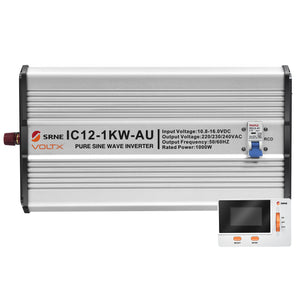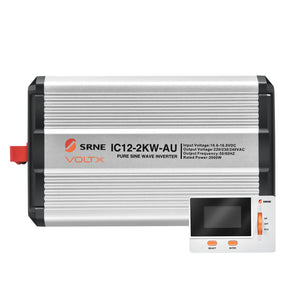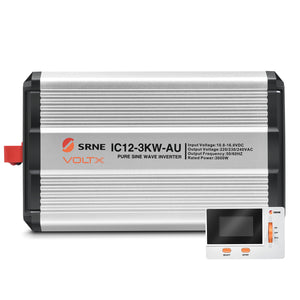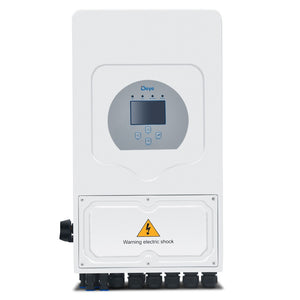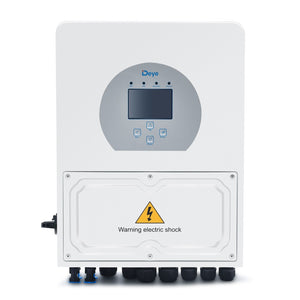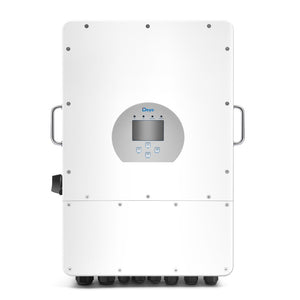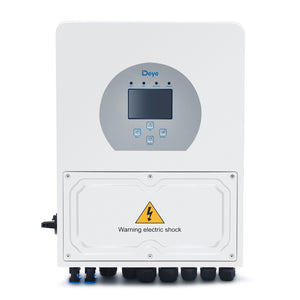VoltX 12V 1KW Pure Sine Wave Inverter + FREE VoltX Inverter LCD Display
$499.00Unit price /UnavailableVoltX 12V 2KW Pure Sine Wave Inverter + FREE VoltX Inverter LCD Display
$599.00Unit price /UnavailableVoltX 12V 3KW Pure Sine Wave Inverter + FREE VoltX Inverter LCD Display
$869.00Unit price /UnavailableDeye 48V 8KW Hybrid Solar Inverter MPPT Charger Regulator Low Voltage
$3,899.00Unit price /UnavailableDeye 48V 5KW Hybrid Solar Inverter MPPT Charger Regulator Low Voltage
$2,199.00Unit price /UnavailableVery low stockDeye 48V 10KW Hybrid Solar Inverter MPPT Charger Regulator Low Voltage
$6,399.00Unit price /UnavailableVery low stockDeye 48V 6KW Hybrid Solar Inverter MPPT Charger Regulator Low Voltage
$2,499.00Unit price /UnavailableVery low stock
How To Choose The Right Size Solar Inverter
With electricity costs soaring across Australia and energy independence becoming increasingly vital, selecting the correct solar inverter size represents one of the most critical decisions in building an efficient solar power system. The solar inverter serves as the heart of your renewable energy setup, transforming the direct current generated by your panels into usable alternating current that powers your home or business. However, choosing the right size solar inverter involves far more than simply selecting the largest model available – it requires a careful balance between your current energy consumption patterns, solar panel capacity, and anticipated future needs to ensure you maximise your return on investment. This comprehensive guide will walk you through a systematic approach to determine the ideal inverter size for your specific circumstances, whether you're outfitting a compact caravan, powering your suburban home, or establishing a robust off-grid setup in the Australian outback.
Understanding Inverter Fundamentals Before You Choose
Before diving into sizing calculations, it's essential to understand that a solar inverter performs the crucial function of converting Direct Current (DC) electricity generated by your VoltX solar panels into Alternating Current (AC) electricity, the standard power format required by household appliances and the electrical grid. Among the various technologies available, pure sine wave inverters represent the premium choice for delivering clean, stable power that's essential for running sensitive electronics like laptops, modern televisions, and medical equipment without risk of damage or interference. This is precisely the technology employed in Outbax's VoltX inverter range, ensuring your valuable devices receive grid-quality power.
For those seeking a more comprehensive solution, hybrid solar inverters have emerged as an all-in-one powerhouse that seamlessly manages energy from solar panels, solar batteries, and the grid simultaneously, storing excess energy for backup power while reducing grid reliance and maximising self-consumption. The Deye inverter series available at Outbax exemplifies this advanced hybrid technology, offering sophisticated energy management capabilities that adapt to your changing power needs throughout the day and night, making them ideal for Australian homes seeking true energy independence.
Step One: Assess Your Total Power Consumption
The foundation of selecting the appropriate inverter size lies in accurately calculating your total power consumption, as your power inverters must be capable of handling the combined wattage of all appliances you might run simultaneously, known as your peak load. Begin by conducting a thorough energy audit of your property, creating a comprehensive list of every appliance and device you intend to power, checking the compliance plate or manual of each item to determine its wattage rating. For instance, a typical Australian refrigerator consumes approximately 150W continuously, while a laptop draws around 60W, and a microwave can surge to 1200W during operation.
To calculate what size inverter you need, simply add up these wattages using the formula: Total Wattage = Appliance 1 (W) + Appliance 2 (W) + Appliance 3 (W), and so forth, paying particular attention to the distinction between continuous load (devices that remain on constantly) and surge load (the initial power spike when motors and compressors start up). This calculation becomes especially critical for off-grid solar inverters where grid backup isn't available, as undersizing could leave you without power when you need it most, while oversizing unnecessarily inflates your initial investment without providing proportional benefits.
Step Two: Match Inverter Size to Your Solar Array
Once you've determined your power requirements, the next crucial step involves matching your inverter capacity to your solar panel array's total output, measured in Watts peak (Wp), ensuring optimal system performance and longevity. The general principle suggests that your inverter's kilowatt rating should closely align with your solar array's kilowatt-peak rating. For instance, a 5kW solar array typically pairs best with a 5kW inverter, though slight variations can offer specific advantages depending on your circumstances. Understanding the nuances of oversizing versus undersizing helps future-proof your system.
Oversizing allows for panel additions later but may reduce efficiency at lower production levels, while undersizing can cause "clipping" during peak production but often improves overall system efficiency. Modern MPPT solar inverters, like those in the Deye hybrid range, incorporate Maximum Power Point Tracking technology that continuously optimises the electrical operating point of your panels, potentially increasing energy harvest by up to 30% – particularly valuable during Australia's variable weather conditions when partial shading or cloud cover would otherwise significantly reduce system output.
Common Inverter Sizes and Their Best Uses
[H4] Small Inverters For Camping and Light Use: 1kW to 3kW
For adventurers and those seeking portable power solutions, small inverters ranging from 1kW to 3kW provide the perfect balance of capability and convenience for caravans, RVs, camping expeditions, or emergency backup power for essential home devices. Outbax's VoltX series offers 1kW, 2kW, and 3kW inverter models in 12V configurations, specifically engineered for vehicle-based systems where space and weight considerations are paramount. These feature pure sine wave output that ensures your sensitive camping gear, from CPAP machines to satellite equipment, operates flawlessly without the interference or damage risk associated with modified sine wave alternatives. The inclusion of a complimentary VoltX Inverter LCD Display with these units provides real-time monitoring of power usage, battery status, and system health, while the competitive pricing makes quality portable power accessible for weekend warriors and grey nomads alike who demand reliability in Australia's remote locations.
Medium Inverters For Average Homes: 5kW to 8kW
The sweet spot for typical Australian households lies within the 5kW to 8kW range, where inverters deliver sufficient capacity to significantly reduce electricity bills while providing comprehensive backup power for essential circuits during grid outages. The Deye 5kW hybrid inverter, 6kW inverter, and 8kW models represent the pinnacle of residential solar technology, seamlessly integrating solar generation, battery storage, and grid connectivity into a unified energy management system that adapts to your household's changing demands throughout the day.
These sophisticated units feature built-in MPPT charge regulators that maximise energy harvest from your panels while intelligent load management ensures critical appliances remain powered during outages, with bundle deals offering exceptional value by including complementary components that would otherwise require separate purchase. The hybrid inverter 48V architecture employed in these systems provides superior efficiency for larger battery banks, reducing cable sizes and system losses while supporting the substantial energy storage required for true overnight self-sufficiency.
Large Inverters For Big Demands: 10kW and Up
Properties with substantial energy requirements, extensive off-grid installations, or small commercial operations demand the robust capabilities offered by 10kW inverter systems and beyond, where the Deye hybrid inverter range continues to excel with models extending to 12kW capacity. These premium units, operating on 48V system architecture, support massive battery banks capable of storing days' worth of energy, making them ideal for remote properties where grid connection is unavailable or unreliable, agricultural operations requiring consistent power for cooling and irrigation systems, or eco-conscious households committed to complete energy independence. The combination of advanced MPPT technology, sophisticated battery management, and generator integration capabilities positions these systems as comprehensive energy solutions rather than simple inverters. These are definitely an investment that typically pays dividends through eliminated electricity bills and protection from rising energy costs.
Making Your Final Decision
After working through the systematic process of calculating your peak appliance load, matching your inverter size to your solar array's output, and identifying the appropriate model category for your needs you're now equipped to make an informed decision that will serve your energy needs for decades to come. Remember that investing the time to choose the right size solar inverter represents the most crucial step towards building a reliable and cost-effective solar power system, as an undersized inverter will fail to meet your needs during critical moments while an oversized unit wastes capital that could be better invested in additional panels or battery storage.
As you explore Outbax's extensive range of pure sine wave inverters and hybrid solutions, consider not just your immediate requirements but also your future energy goals, whether that's expanding your system, adding an electric vehicle charger, or achieving complete grid independence – because the right inverter choice today becomes the foundation of your energy independence tomorrow.
Frequently Asked Questions
- What is a hybrid solar inverter?
A hybrid inverter is an intelligent all-in-one device that manages power from multiple sources including solar panels, solar batteries, and the electrical grid simultaneously. It can store excess solar energy in batteries during sunny periods, automatically switch to battery power during outages, and even sell surplus energy back to the grid where permitted, making it the ideal choice for maximising self-consumption and achieving energy independence.
- How do I calculate what size inverter I need for my home?
Calculate your inverter size by listing all appliances and devices you plan to run simultaneously, noting each item's wattage from its compliance plate or manual, then adding these together to determine your peak load. Choose an inverter with a continuous output rating at least 20-25% higher than your calculated peak load to ensure reliable operation and accommodate occasional power surges from motor-driven appliances.
- Can I use a bigger inverter than my solar panels?
Yes, oversizing your inverter by up to 30% of your panel capacity is a common strategy that allows for future solar array expansion without replacing the inverter. However, excessive oversizing reduces efficiency at lower production levels and increases initial costs unnecessarily, so it's best to keep the inverter capacity within reasonable limits of your current or planned panel array.
- What does MPPT mean on a solar inverter?
MPPT (Maximum Power Point Tracking) is sophisticated technology that continuously monitors and adjusts the electrical operating point of your solar panels to extract maximum possible power under varying conditions. This feature, standard in quality inverters like the Deye range, can improve energy harvest by up to 30%, particularly during cloudy weather, partial shading, or temperature fluctuations common in Australian conditions.
- What can a 3kW pure sine wave inverter run?
A 3kW (3000 watt) pure sine wave inverter can simultaneously power multiple household appliances such as a refrigerator (150W), LED lights throughout your home (100W total), television (200W), laptop (60W), and still have capacity for a microwave (1200W) or power tools. The pure sine wave output ensures safe operation of sensitive electronics including medical equipment, audio systems, and variable-speed motors without interference or damage.
- What is the main difference between a 12V and a 48V inverter system?
The voltage specification refers to the battery bank configuration, with 12V systems like the VoltX range being ideal for smaller, portable applications in caravans and boats where space is limited. In contrast, 48V systems used in larger Deye models offer superior efficiency for substantial home installations, allowing smaller cable sizes, reduced power losses, and support for extensive battery banks required for multi-day autonomy.
- Why is a pure sine wave inverter considered better?
Pure sine wave inverters produce clean, smooth AC power identical to or better than grid electricity, ensuring optimal performance and longevity for all electrical devices, particularly sensitive electronics with microprocessors. Unlike modified sine wave inverters that create "choppy" power causing interference, heating, and potential damage, pure sine wave models protect your investment in appliances while operating more quietly and efficiently.
- Do I need a hybrid inverter if I don't have batteries yet?
Purchasing a hybrid inverter initially without batteries is an excellent future-proofing strategy, as it functions perfectly as a standard grid-tie solar inverter while maintaining the capability to integrate battery storage later without system replacement. This approach spreads your investment over time while ensuring your system can evolve with advancing battery technology and declining storage costs.
- Are Deye hybrid inverters a good choice for off-grid living?
Deye hybrid inverters excel in off-grid applications thanks to their robust design, comprehensive battery management capabilities, and ability to integrate multiple power sources including solar, batteries, and backup generators. Their sophisticated load management, extensive programming options, and proven reliability in harsh Australian conditions make them a trusted choice for remote properties requiring dependable, autonomous power systems.
Frequently Asked Questions
- What is a hybrid solar inverter?
- How do I calculate what size inverter I need for my home?
- Can I use a bigger inverter than my solar panels?
- What does MPPT mean on a solar inverter?
- What can a 3kW pure sine wave inverter run?
- What is the main difference between a 12V and a 48V inverter system?
- Why is a pure sine wave inverter considered better?
- Do I need a hybrid inverter if I don't have batteries yet?
- Are Deye hybrid inverters a good choice for off-grid living?
